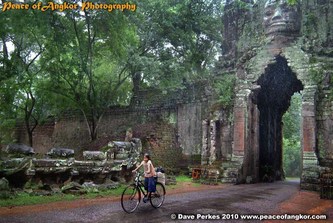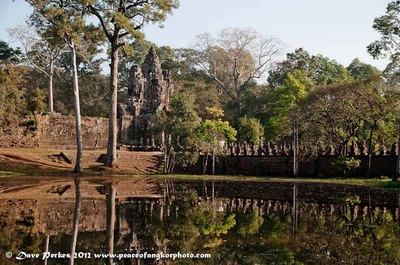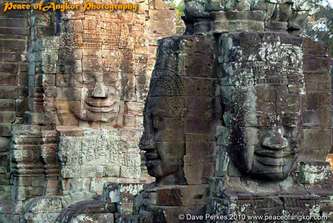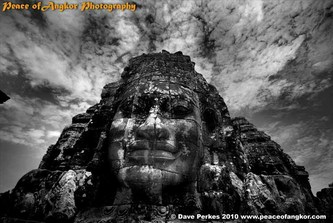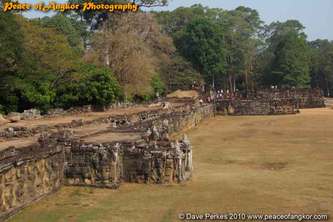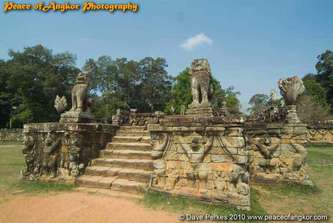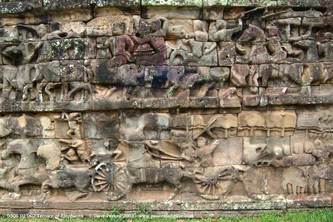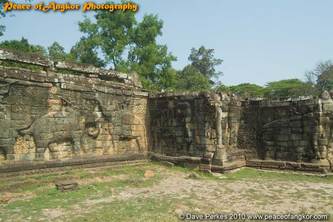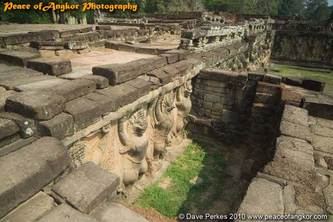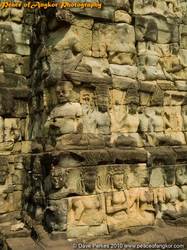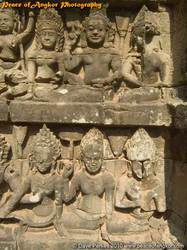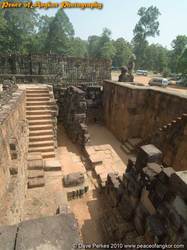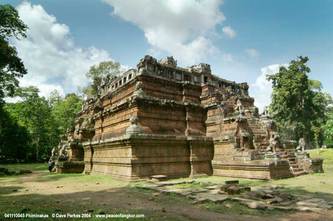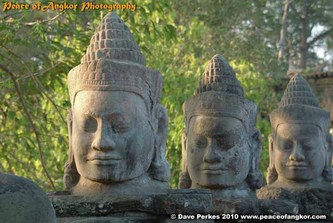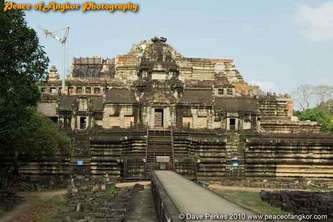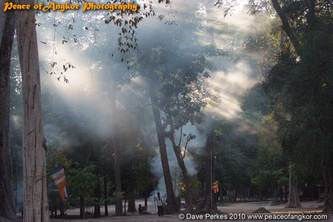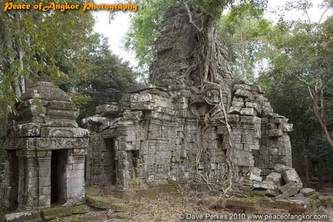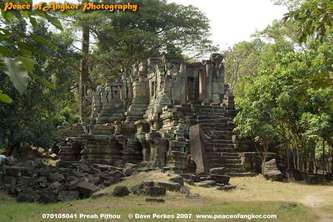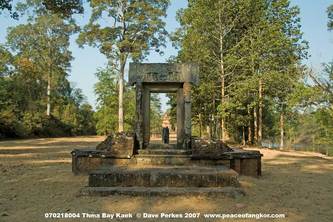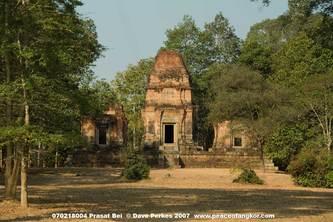PEACE OF ANGKOR PHOTOGRAPHY
ANGKOR THOM
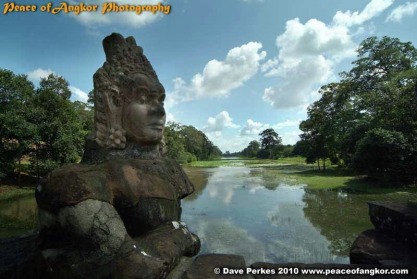
The Moat of Angkor Thom
Angkor Thom was the centre of the 12th Century city of Angkor. With over 1 million people, it was the worlds largest city. At that time London and Paris at around 30,000, were thought to be the largest cities.
At the centre of the great city of Angkor lies the Bayon Temple. It has 52 towers with the huge serene faces thought to represent King Jayavarman VII. To the north is the great plaza adjoining 300 metre long Elephant terrace, which must have been a spectacular meeting place 800 years ago. Behind this are the ruins of the Royal Palace and the pyramid temple of Phimeanakas.
The area to the east of the Royal Palace was a meeting place where thousands watched the entertainment and dancing on the huge Elephants Terrace.
At the centre of the great city of Angkor lies the Bayon Temple. It has 52 towers with the huge serene faces thought to represent King Jayavarman VII. To the north is the great plaza adjoining 300 metre long Elephant terrace, which must have been a spectacular meeting place 800 years ago. Behind this are the ruins of the Royal Palace and the pyramid temple of Phimeanakas.
The area to the east of the Royal Palace was a meeting place where thousands watched the entertainment and dancing on the huge Elephants Terrace.
You are in Angkor Thom - Angkor Wat - Angkor Thom - Bayon - Ta Prohm - Preah Khan - Eastern Temples
Cyclist at Angkor Thom Gate Angkor Thom South Gate face Angkor Thom South Causeway
The gates of Angkor Thom are impressive; especially after rain! All the five gates are identical. The causeways are flanked by the heads of Gods and Demons holding a Naga or serpent. Hindus and Buddhists look at the Naga in a positive way. The naga causeways and stairways represent a way into enlightenment or Heaven.
The Bayon.
At The centre of the Ancient City of Angkor Thom lies the multi-faced Bayon. For more on this, see our page on The Bayon
Elephants Terrace
North of the Bayon is a great plaza which was used as a meeting place for celebrations. The centre piece is the Terrace of Elephants.With three main stairways This 350 metre long stage was lined with reliefs of elephants and Garuda figures. It was used for spectacular shows and festivals with the King in attendance. The colourful scenes with dancers and musicians would have been an amazing sight to see. Behind one of the steps are a well preserved set of Garudas which were built over and covered during a later addition to the terrace.
North of the Bayon is a great plaza which was used as a meeting place for celebrations. The centre piece is the Terrace of Elephants.With three main stairways This 350 metre long stage was lined with reliefs of elephants and Garuda figures. It was used for spectacular shows and festivals with the King in attendance. The colourful scenes with dancers and musicians would have been an amazing sight to see. Behind one of the steps are a well preserved set of Garudas which were built over and covered during a later addition to the terrace.
Leper King Terrace
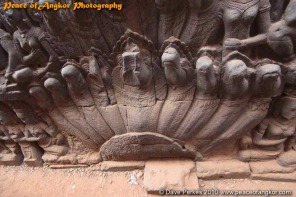
The Nine headed Naga
To the north of the famous Terrace of the Elephants in Angkor Thom is the Terrace of the Leper King. It dates from the Bayon period and was built in the late 12th or early13th century. It has seven spectacular tiers of reliefs, depicting Apsaras and scenes from the king's court, as well as hundreds of human figures. There is some speculation about the meaning of the terrace. At the top of the terrace is a statue that, when discovered, was covered in moss, giving the impression of leprosy. It was believed to represent Jayavarman VII.
The Legend of the Leper King
There is a legend, depicted in the Bayon temple, that the king fought a giant snake that spat poison at him, and he contracted leprosy. The original figure carved in the 14th century was moved to the National Museum in Phnom Penh and is now thought to be Yama, the god of death.
Behind the terrace lies an older gallery that was concealed until it was exposed during restoration work in the late 1990s. The hidden carvings are easily accessible down a narrow corridor, with modern concrete supporting the original structure. The entrance has animal figures, including Mekong dolphins, crocodiles, fish and crabs. The narrow terrace zigzags behind, with hundreds of figures including spectacular nine-headed Nagas.
Both the Leper King and Elephants terraces are best seen and photographed in the mornings.
The Legend of the Leper King
There is a legend, depicted in the Bayon temple, that the king fought a giant snake that spat poison at him, and he contracted leprosy. The original figure carved in the 14th century was moved to the National Museum in Phnom Penh and is now thought to be Yama, the god of death.
Behind the terrace lies an older gallery that was concealed until it was exposed during restoration work in the late 1990s. The hidden carvings are easily accessible down a narrow corridor, with modern concrete supporting the original structure. The entrance has animal figures, including Mekong dolphins, crocodiles, fish and crabs. The narrow terrace zigzags behind, with hundreds of figures including spectacular nine-headed Nagas.
Both the Leper King and Elephants terraces are best seen and photographed in the mornings.
Other Sites within Angkor Thom.

Angkor Thom Plaza and Prasats Sour Prat
At the rear of the plaza are 12 towers the Prasats Sour Prat. Tight rope walkers used to perform across what is now the road to the Victory Gate. Behind the towers are the Khleangs or temples of the storehouses and the atmospheric Preah Pithou group of temples.
For those who have the time; a walk around the walls of Angkor Thom will give a tourist a different perspective on Angkor. It is a long peaceful 12 kilometre walk linking all five gates. There are four Corner temples (Prasat Chrung) and a secret passage under the walls to the moat. You can walk around part of this.
Phiminakas Three heads; South Gate The Baphoun Smoke at Bayon East gate eyes
For those who have the time; a walk around the walls of Angkor Thom will give a tourist a different perspective on Angkor. It is a long peaceful 12 kilometre walk linking all five gates. There are four Corner temples (Prasat Chrung) and a secret passage under the walls to the moat. You can walk around part of this.
Phiminakas Three heads; South Gate The Baphoun Smoke at Bayon East gate eyes
Prasat Chrung Preah Pithou Interior of North Khleang Thma Bei Kek Prasat Bei
The Baphuon: a giant 3D Puzzle
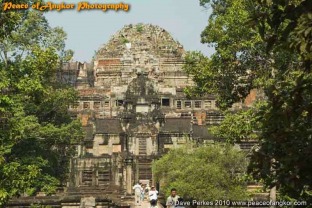
The Baphuon
The 11th century Baphoun temple, south of the Terrace of the Elephants, was one of the most spectacular of all the Angkor temples. The three-tiered pyramid had a huge reclining Buddha on its western side and a meditating Buddha at its summit. Attempts were made to restore this temple in 1918, but a series of disastrous collapses and dismantlement up to the early 1940s, left the temple in a state of ruin with over 300,000 numbered stone pieces; but no plans, which were lost during the war. The vast 3D puzzle was pieced together by the l'Ecole Française d'Extrême-Orient and the French government. In july 2011 the major part of the Baphuon Temple was completed. The re-opening was marked on 3rd July 2011 by a ceremony attended by King Norodom Sihamoni and French Prime Minister Francois Fillon.

For more information on our tours to Angkor Wat and many other temple sites in the Angkor Park

